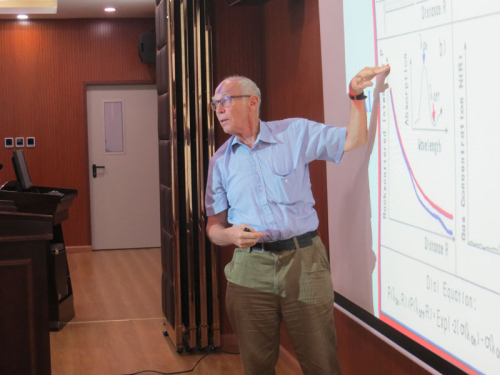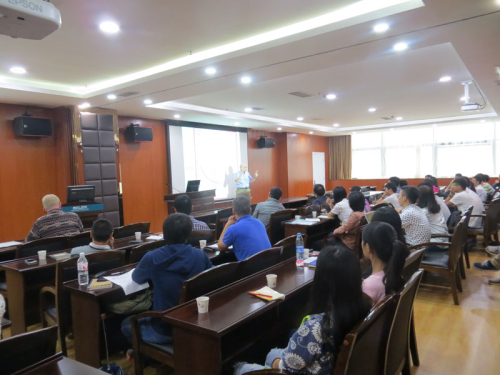Invited by Professor FENG Xinbin of the State Key Laboratory of Environmental Geochemistry (SKLEG), Prof. Sune Svanberg from Lund University (Sweden) and the South China Normal University (SCNU), visited IGCAS during September 6th ~ 8th.
On the morning of September 7th, Prof. Sune Svanberg presented a talk titled “Monitoring of atmospheric mercury using differential absorption lidar techniques”. In his talk, Prof. Sune Svanberg showed his team's achievements regarding mobile lidar monitoring systems, and introduced the basics of the technique. Then, Prof. Sune Svanberg demonstrated the remote sensing mercury monitoring at factories, mercury mines, and geothermally active sites using differential absorption lidar techniques in atmospheric monitoring in Italy, Slovenia, Iceland and Spain. Prof. Sune Svanberg looked forward to the cooperation with the institute in using differential absorption lidar techniques to monitor mercury, SO2 and NO in the atmospheric environment, mostly utilizing the new mobile laser radar system developed at SCNU.

Prof. Sune Svanberg at the presentation

The audience
The presentation was greatly appreciated by the audience, and followed by the lively interactive discussions. The presentation attracted many professors and students from the institute to attend.
In the afternoon, Prof. Sune Svanberg had a meeting with Prof. FENG Xinbin's mercury group. They reached a framework agreement for a cooperative research project utilizing applied laser spectroscopy in Guizhou.
Sune Svanberg is a professor at Lund University and was the head of the Lund Laser Centre. Since 2011 he is also a part-time distinguished professor at the South China Normal University (SCNU). His basic studies include the studies of radiative properties of atoms and ions as well as superintense laser/matter interactions. He is also a leading figure in the field of laser spectroscopy applications, including laser radar sounding of pollutants, laser diagnostics of combustion processes, and laser-based detection/treatment of disease. He is a member of the Swedish Royal Academy of Sciences (10 years as a member of Nobel Committee for Physics; two years as chairman). He is the recipient of the first Azko Nobel Science Award (1999). In 2010 he was awarded with the Adelskold Medal of the Royal Academy of Sciences and the Large Gold Medal from the Royal Academy of Engineering Sciences, Stockholm. He is an “Einstein Professor” of the Chinese Academy of Sciences since 2006, and received China´s highest distinction for non-Chinese, the China Friendship Award in 2013.
(By YUAN Wei and YU Ben, Images by GUO Sheng)